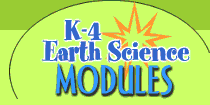Topic Overview: Forests
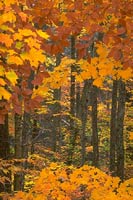 Forest biomes are made up of trees and other woody plants. There are many types of forests. They are located in different parts of the world. The climate is different in each type of forest. Therefore, the plants and animals that can live in each type of forest are different. Photo: Deciduous forest in temperate biome. Forest biomes are made up of trees and other woody plants. There are many types of forests. They are located in different parts of the world. The climate is different in each type of forest. Therefore, the plants and animals that can live in each type of forest are different. Photo: Deciduous forest in temperate biome.
Berkeley's Biomes group divides the forests of the world into three main groups. These groups are tropical, temperate and boreal forests. Another type of forest is the temperate rain forest.
Tropical forests are found near the equator. They grow in parts of South America, Africa, and the East Indies. It is very hot in these parts of the world. Some places there are also very wet. They receive a lot of rain. That is why tropical forests are called "rainforests." The climate in these forests is the same nearly all year. There is no cold winter season. The only seasons are rainy and dry.
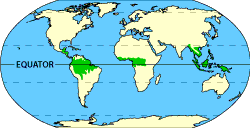
Tropical forests contain more types of living things than any other biome. Many types of large trees grow in tropical forests. The tops of these trees overlap a lot. They block sunlight from reaching the ground. Without sunlight few plants can grow below the big trees. Many types of animals live in tropical forests too. They include monkeys, birds, large snakes, and insects. Most of these creatures along with many types of plants live in the tops of the large trees. These animals can move through the forest without ever touching the ground!
Temperate rain forests are found in the Pacific Northwest of the United States. They also occur in southern Chile and northern Japan. Temperate rainforests are similar to both tropical forests and temperate forests. Like tropical forests, temperate rainforests are very wet. They get a lot of rain each year. However, temperate rainforests are cooler than tropical forests.
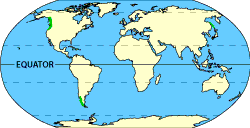
Large coniferous (cone-bearing) trees grow in temperate rainforests. These trees include redwoods and the giant sequoia. The trees in temperate rainforests are among the oldest in the world. They are also the largest. Tunnels have even been built through some of these giant trees! Mosses commonly cover trees in temperate rain forests. The mild, wet temperate rainforests are also home to slugs. More slugs live in these forests than anywhere else on Earth. Large elk live in these forests too.
Temperate forests are found between Earth's poles and the tropics. They are in parts of North America, Asia, and Europe. These forests are cooler and drier than tropical forests. The climate in temperate forests goes through four seasons. There is a warm summer season, a cold winter season, and two in-between seasons—spring and fall. Each of the four seasons lasts about three months.
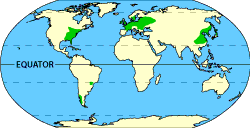
Many types of trees grow in temperate forests. Some of them are deciduous trees. These trees have broad (flat and wide) leaves. "Deciduous" means they lose most of their leaves during the cold season. These trees include maple, oak, and beech. Evergreen trees grow in temperate forests too. These trees have needles instead of broad leaves. Evergreen trees include hemlock, spruce, and fir. They stay green all year long. They do not lose all of their needles during the cold season. There are many open spaces between the tops of trees in temperate forests. Sunlight is able to reach the ground. Small shrubs are able to grow beneath the large trees. Animals like deer, squirrels, and small snakes live in these forests. Most people live in the temperate forest biome.
Boreal forests, or taiga, make up the largest land-based biome. They are found between 50 and 60 degrees north latitudes. They are in parts of Eurasia, North America, Siberia, Scandinavia, Alaska, and Canada. These forests are cold. They receive very little precipitation. Most of it is in the form of snow. The climate in boreal forests goes through two seasons. There is a moist, somewhat warm summer. Boreal summers are very short. There is a cold, dry winter. Boreal winters are very long.
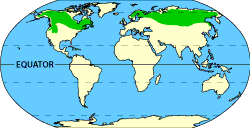
Evergreen trees like fir and spruce grow in boreal forests. These trees grow close together. They block sunlight from reaching the ground. Without sunlight few plants can grow below the trees. Woodpeckers, hawks, moose, and bear live in boreal forests.
Photo courtesy of Philip Greenspun. |
